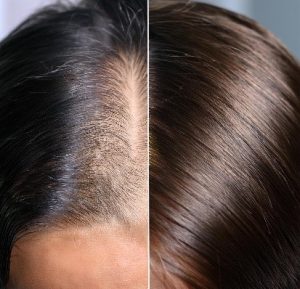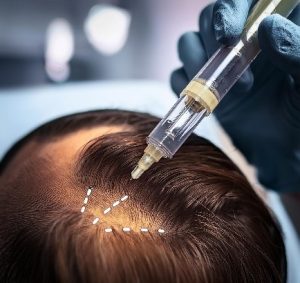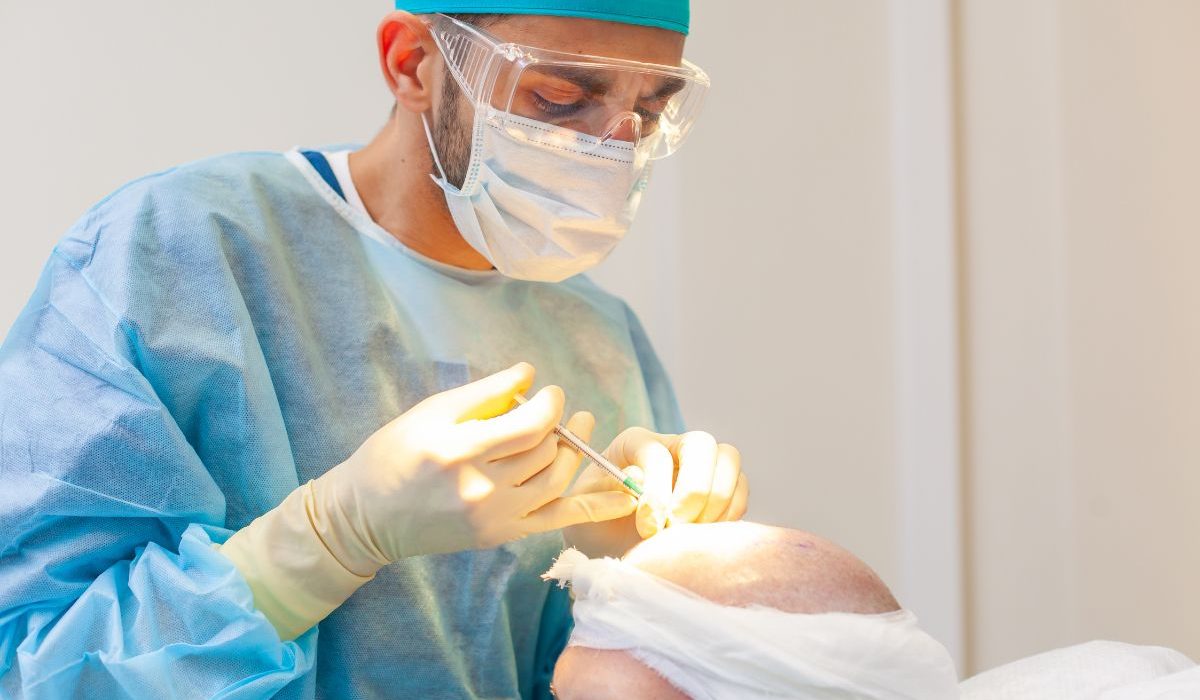HAIR TRANSPLANT

Hair transplantation is a medical procedure where hair follicles are taken from one part of your body, usually the back or sides of your head, and implanted into areas where you have thinning or no hair. This is done to restore hair in bald or thinning spots, making it look fuller and more natural. Hair loss is a common issue that can affect anyone. It can be caused by genetics, aging, hormonal changes, or medical conditions.
Some people lose hair gradually, while others may experience sudden hair loss. This can impact self-esteem and make people feel less confident. Hair transplants offer a solution to this problem by restoring lost hair.
There are two main methods: FUE (Follicular Unit Extraction) and FUT (Follicular Unit Transplantation). In FUE, individual hair follicles are removed one by one from the donor area (usually the back of the head) using a small tool. These follicles are then carefully placed into the areas where hair is thin or missing. This method has a quicker recovery time. In FUT, a strip of skin with hair is taken from the donor area. 
The strip is then divided into small grafts, each containing a few hair follicles. These grafts are implanted into the areas with hair loss. FUT can often transplant more hair in a single session. Both methods aim to give you a natural look, with the transplanted hair growing just like your regular hair. Choosing between FUE and FUT depends on several factors, including the extent of your hair loss, your budget, and your preference for scarring. It’s important to consult with a hair transplant specialist who can help you decide which method is best for you based on your needs and goals.
 Pre-care is very important so before getting a hair transplant, you should follow some simple steps to ensure the best results. Start by having a detailed consultation with your doctor, where you discuss your medical history. Your doctor might ask you to stop taking certain medications, like blood thinners, and pause any supplements, such as Vitamin E or fish oil, at least a week before the procedure, as these can increase bleeding. It’s also crucial to quit smoking at least a week before the surgery since smoking can slow down healing. Similarly, avoid drinking alcohol for at least three days before your transplant because it can affect blood flow. On the day of your surgery, wear comfortable, loose-fitting clothing that doesn’t need to be pulled over your head to prevent disturbing your scalp afterward. It’s also a good idea to eat a light meal before the surgery and stay hydrated, but don’t overdo it. Try to stay relaxed, knowing that hair transplants are generally safe and that your doctor is experienced. If you have any last-minute questions or concerns, don’t hesitate to ask your doctor or the medical staff—they’re there to help you feel comfortable and confident. By following these simple guidelines, you’ll be well-prepared for your hair transplant.
Pre-care is very important so before getting a hair transplant, you should follow some simple steps to ensure the best results. Start by having a detailed consultation with your doctor, where you discuss your medical history. Your doctor might ask you to stop taking certain medications, like blood thinners, and pause any supplements, such as Vitamin E or fish oil, at least a week before the procedure, as these can increase bleeding. It’s also crucial to quit smoking at least a week before the surgery since smoking can slow down healing. Similarly, avoid drinking alcohol for at least three days before your transplant because it can affect blood flow. On the day of your surgery, wear comfortable, loose-fitting clothing that doesn’t need to be pulled over your head to prevent disturbing your scalp afterward. It’s also a good idea to eat a light meal before the surgery and stay hydrated, but don’t overdo it. Try to stay relaxed, knowing that hair transplants are generally safe and that your doctor is experienced. If you have any last-minute questions or concerns, don’t hesitate to ask your doctor or the medical staff—they’re there to help you feel comfortable and confident. By following these simple guidelines, you’ll be well-prepared for your hair transplant.
During procedure, it’s important to stay calm and comfortable. The process usually begins with the doctor numbing the donor and recipient areas of your scalp, so you won’t feel pain during the surgery. You might feel some pressure or slight discomfort, but the local anesthesia will keep you comfortable. It’s a good idea to relax and trust your medical team, as they are experienced in performing the procedure. Throughout the surgery, you’ll be awake, and you can usually watch TV, listen to music, or even chat with the medical staff to pass the time. The procedure can take several hours, depending on how many hair follicles are being transplanted. During this time, it’s important to stay as still as possible to help the doctor work accurately. You might be given short breaks to stretch or use the restroom, but overall, it’s best to remain relaxed and patient.
Post-care after a hair transplant is essential for a smooth recovery and the best results. For the first few days, rest and avoid touching or scratching your scalp to protect the newly transplanted hair follicles.
Avoid washing your hair for the first 48 hours. Also, stay away from direct sunlight and refrain from smoking and drinking alcohol for at least a few days after the procedure, as these can interfere with the healing process. As your scalp heals, you might notice some scabbing or shedding of the transplanted hair, which is normal and part of the process. Keep your follow-up appointments with your doctor to monitor your progress and address any concerns. Your doctor will also guide you on when to resume your normal hair care routine and what products to use. By following these simple aftercare steps, you’ll support the growth of your new hair and help ensure the best possible outcome from your hair transplant.
Hair transplants are very safe, but there are some contraindications, or reasons why certain people should avoid the procedure. For example, if you have a medical condition that affects your ability to heal, like uncontrolled diabetes or a blood clotting disorder, a hair transplant may not be recommended because your scalp might not heal properly after surgery.
 Choosing the right clinic for your hair transplant is crucial to achieving the best results, and that’s why you should consider getting your procedure done at London Aesthetics And Rejuvenation Centre. Our clinic is renowned for its exceptional care, advanced technology, and highly experienced specialists who have performed countless successful hair transplants. Each treatment is customized to fit your specific needs, so you’ll get the best results. When you choose us, you’re choosing a clinic that truly cares about helping you feel confident and look your best.
Choosing the right clinic for your hair transplant is crucial to achieving the best results, and that’s why you should consider getting your procedure done at London Aesthetics And Rejuvenation Centre. Our clinic is renowned for its exceptional care, advanced technology, and highly experienced specialists who have performed countless successful hair transplants. Each treatment is customized to fit your specific needs, so you’ll get the best results. When you choose us, you’re choosing a clinic that truly cares about helping you feel confident and look your best.



